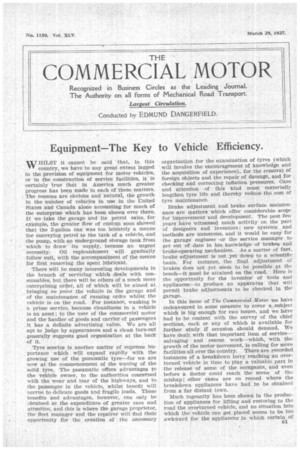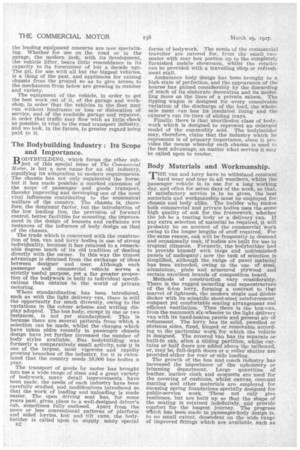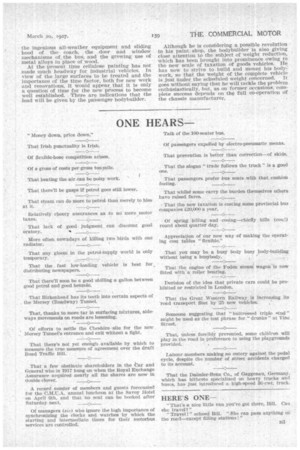Equipment—The Key to Vehicle Efficiency.
Page 71

Page 72

Page 73

If you've noticed an error in this article please click here to report it so we can fix it.
W HII.ST it cannot be said that, in this country, we have to any great extent lagged in the provision of equipment for motor vehicles, or in the construction of service facilities, it is certainly -true that in America much greater progress has been made in each of these matters. The reasons are obvious and natural, the growth in the number of vehicles in use in the United States and Canada alone accounting for much of the enterprise which has been shown Over there. If we take the garage and its petrol sales, for example, the greater flow of custom soon showed that the 2-gallon can was too leisurely a means for conveying petrol to the tank of a vehicle, and the pump, with an underground storage tank from which to draw its supply, became an urgent necessity: Oil replenishment will gradually follow suit, with the accompaniment of the means for first removing the spent lubricant.
There will be many interesting developments in the branch of servicing which deals with consumables, but there will be others of a much more enterprising order, all of which will be aimed at bringing au point the vehicle in the garage and of the maintenance of running order whilst the vehicle is on the road. For instance, washing is a prime service, because cleanliness in a vehicle is an asset ; to the user of the commercial motor and the haulier of goods and carrier of passengers it has a definite advertising value. We are all apt to judge by appearances and a clean turn-out generally suggests good organization at the back of it.
Tyre service is another matter of supreme importance which will expand rapidly with the growing use of the pneumatic tyre—for we are now at the commencement of the waning of the solid tyre. The pneumatic offers advantages to the vehicle owner, to the authorities concerned with the wear and tear of the highways, and to the passenger in the vehicle, whilst benefit will accrue to delicate goods and fragile loads. These benefits and advantages, however, can only be obtained at the expenditure of greater care and attention; and this is where the garage proprietor, the fleet manager and the repairer will find their opportunity for the creation of the necessary organization for the examination of tyres (which will involve the encouragement of knowledge and the acquisition of experience), for the removal of foreign objects and the repair of damage, and for checking and correcting inflation pressures. Care and attention of this kind must materially lengthen tyre life and thereby reduce the cost of tyre maintenance.
Brake adjustment and brake surface maintenance are matters which offer considerable scope for improvement and development. The past few years have witnessed much activity on the part of designers and inventors; new systems and methods are numerous, and it would be easy for the garage engineer .or the service manager to get out of date in his knowledge of brakes and brake-operating mechanism. Asa matter of fact, brake adjustment is not yet down to a scientific basis. For instance, the final adjustment of brakes does not yet seem to be possible at the bench—it must be attained on the road. Here is the opportunity for the inventor of tools and appliances—to produce an apparatus that will permit brake adjustments to be checked in the garage.
In this issue of The Commercial Motor we have endeavoured in some measure to cover a:subject .
which is big enough for two issues, and we have had to be content with the survey of the chief sections, each or any of which is available for further study if occasion should demand. We have dealt with that important item of service— salvaging and rescue work—which, -with the growth of the motor movement, is calling for more facilities all over the country. There are recorded Instances of a breakdown lorry reaching an over turned vehicle in time to play a valuable part in the release of some of the occupants, and even before a doctor could reach the scene of the mishap ; other cases are on record where the breakdown appliances have had to be obtained from a far distant town.
Much ingenuity has been shown in the production of appliances for lifting and restoring to the road the overturned vehicle, and no situation into which the vehicle can get placed seems to be too awkward for the appliances in which certain of the leading equipment concerns are now specializing. Whether for use on the road or in the garage, the modern jack, with its development, the vehicle lifter, bears little resemblance in its capacity to its forerunner of but a decade ago. The pit, for use with all but the biggest vehicles, is a thing of the past, and appliances for raising chassis from the ground so as to give• access to the mechanism from below are growing in number and variety.
The equipment of the vehicle, in order to get the best work out of it, of the garage and workshop, in order that the vehicles in the fleet may run without hindrance or loss or dislocation of service, and of the roadside .garage and repairer, in order that traffic may flow with as little check as possible, is vital to the road transport industry, and we look, in the future, to greater regard being paid to it.
The Bodybuilding Industry : Its Scope and Importance.
BODYBUILDING, which forms the other subjectject of this special issue of The Commercial Motor, is but a new name for an old industry, signifying its adaptation to modern requirements. The chassis has not only supplanted the horse, but it has made possible a marked extension of the scope of passenger and goods transport, thereby improving and developing one of the most vital influences contributing to the economical welfare of the country. The chassis is, therefore, the dominant factor, but the introduction of the low loading line, the provision of forward control, better facilities for mounting, the improvement in the design of bonnets and radiators are instances of the influence of body design on that of the chassis.
The trade which is concerned with the construction of bus, van and lorry bodies is one of strong individuality, because it has retained to a remarkable degree much of its old tradition of dealing directly with the owner. In this way the utmost advantage is obtained from the exchange of ideas between designer and user. Although each passenger and commercial vehicle serves a strictly useful purpose, yet a far greater proportion of the bodywork is built to individual specifications than obtains in the world of private motoring.
Where standardization has been introduced, such as with the light delivery van, there is still the opportunity for much diversity, owing to the variations in the colour scheme and writing display adopted. The bus body, except in one or two instances, is not yet standardized. This is because there are several patterns from which a selection can be made, whilst the changes which have taken ple-ce recently in passenger chassis design have yet further increased the number of body styles available. Bus bodybuilding was formerly a comparatively small activity, now it is one of the largest, most vigorous and rapidly growing branches of the industry, for it is calculated that the country needs 10,000 bus bodies a year.
The transport of goods by motor has brought into use a wide range of sizes and a great variety of bodywork, many detail improvements have been made, the needs of each industry have been carefully studied. and modifications introduced so that the work of loading and unloading is made easier. The open driving seat has, for some years past, given place to a well-designed driver's cab, sometimes, fully enclosed. Apart from the more or less conventional patterns of platform and sided lorries, box and tilt vans, the bodybuilder is eked upon to supply many special D2 forms of bodywork. The needs of the commercial traveller are catered for, from the small twoseater with rear box portion up to the completely furnished mobile showroom, whilst the retailer can be provided with a travelling shop or refreshment stall.
Ambulance body design has been brought to a high state of perfection, and the. appearance of the hearse) has gained considerably by the discarding of much of its elaborate decoration and its modelling more on the lines of a private saloon. The tipping wagon is designed for every conceivable variation of the discharge of the load, the wholesale meat van has its insulated lining and the caterer's van its tiers of sliding trays.
Finally, there is that unorthodox -class of bodywork which is designed to represent an enlarged model of the commodity sold. The bodybuilder may, therefore, claim that the industry which he represents is of primary importance, since it provides the means whereby each chassis is used to the best advantage, no matter what service it may be called upon to render.
Body Materials and Workmanship.
rr HE van and lorry have to withstand constant hard wear and tear in all weathers, whilst the passenger vehicle is in use for a long working day, and often for seven days of the week, so that, if satisfactory service is to be given, the best materials and workmanship must be employed for chassis and body alike. The builder wile makes both commercial and private bodies uses the same high quality of ash for the framework, whether the job be a touring body or a delivery van. If any extra selection of material be required, it will probably be on account of the commercial work owing to the longer lengths of stuff required. For the same reason, oak will be frequently in demand and occasionally teak, if bodies are built for use in tropical climates. Formerly, the bodybuilder had to provide himself with large and unblemished panels of mahogany ; now the task of selection is simplified, although the range of panel material has been -extended, owing to the use of steel, aluminium, plain and armoured plywood and certain excellent brands of composition board.
Methods of construction vary considerably. There is the rugged mounting and superstructure of the 6-ton lorry, forming a contrast to that marvel of lightness, the modern single and double decker with its scientific sheet-steel reinforcement, compact yet comfortable seating arrangement and efficient ventilation. Then there is the box-van, from the mammoth six-wheeler to the light delivery van with its hand-beaten panels and general air of refinement. The lorry has its solid, panelled or skeleton sides, fixed, hinged or removable according to the particular work, for which the vehicle Is designed. The covered van has its separate or built-in cab, often a sliding partition, whilst curtains or half doors are added above the tailboard, or, may be, full-depth doors or a roller shutter are provided either for rear or side loading. The growth of the bus and coach industry has increased the importance of the upholstery or trimming department. Large quantities of leather, leather cloth and moquette are used for the covering of cushions, whilst canvas, coco-nut matting and other materials are employed for encasing spring foundations specially designed for public-service work. These not only give resilience, but are built up so that the shape of the seating is retained indefinitely, and provide c mfort for the longest journey. The progress TTiich has been made in passenger-body design is, to no small extent, dependent on the wide range of improved fittings which are available. such as the ingenious all-weather equipment and sliding hood of the coach, the door and window mechanisms of, the bus, and the growing use of metal alloys in place of wood. At thefl present time cellulose painting has not made much headway for industrial vehicles. In view of the large surfaceS to be treated and the importance of the time factor, both for new work and renovations, it would appear_ that it is only a question' of time for the new process to become well established. There are indications that the _lead will be given by the passenger bodybuilder. Although he is considering a possible revolution in his paint shop, the bodybuilder is also giving close attention to the subject of weight reduction, which has been brought into prominence owing to the new scale of taxation of goods vehicles. He has now to strive to build and mount his body: work, so that the weight of the complete vehicle is just under the scheduled weight concerned. It goes without saying that he will tackle the problem enthusiastically, hut, as on former occasions, completesuccess depends on the full co-operation of the chassis manufacturer.












































































































































































